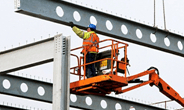Steel Markets

AGC: Construction Costs Decline in August, Headwinds Persist
Written by David Schollaert
September 16, 2022
The prices contractors pay for construction materials and services—chiefly for new nonresidential construction—declined 1.1% month-on-month (MoM) in August, as a steep drop in fuel prices masked increases in the cost of other construction inputs, the Associated General Contractors of America (AGC) reported in its latest analysis of government data.
AGC cautioned that limited price declines cannot undo the harm of clogged supply lines and labor shortages.
“Today’s price report highlights the mixed conditions contractors are experiencing, with many costs still rising sharply while others take a breather,” said Ken Simonson, AGC’s chief economist. “Meanwhile, an industry survey we recently released found that supply-chain issues and labor availability are delaying many construction projects.”
AGC’s survey released on Aug. 31 asked construction firms about the impact of shortages and delivery delays on project completion times, among other topics. About 82% of firms reported projects had been delayed due to longer lead times or shortages of materials, while 66% reported delays due to shortages of employees or subcontractors.
Citing the Bureau of Labor Statistics, AGC said that the producer price index (PPI) for inputs to nonresidential construction—the prices charged by goods producers and service providers such as distributors and transportation firms—slipped 1.1% through August but were still 13% higher year-on-year (YoY).
Meanwhile, the index for goods other than energy and food rose 0.3% after declining for two months. The index for services was similarly mixed, with an overall dip of 0.4% but with a 1.2% increase in the index for services other than trade, transportation, and warehousing.
A diverse mix of inputs accounted for the increase in the cost index in August, partially offsetting declines in fuel, lumber, and some metal products, Simonson said.
The price index for gypsum building materials such as wallboard jumped 3.3% for the month. Indexes rose for construction machinery and equipment (2.6%), flat glass (2.4%), copper and brass mill shapes (2.0%), ready-mixed concrete (1.6%), and asphalt paving mixtures and blocks (1.0%). Among services, the price index for equipment rental and leasing climbed 3.7%.
These increases were more than offset by one-month decreases in August in the index for diesel fuel (-13.4%), steel mill products (-5.7%), aluminum mill shapes (-3.9%), and lumber and plywood (-2.9%). The fuel price drop contributed to a 1.9% fall in the index for truck transportation of freight.
AGC said supply-chain disruptions, along with a shortage of qualified construction workers, threaten to delay and increase the cost of much-needed infrastructure and manufacturing construction. They urged public officials to help keep freight moving and invest in workforce development.
“Declines in materials costs mean little if neither goods nor workers are available,” said Stephen Sandherr, AGC’s CEO. “Federal officials need to do all they can to remove supply bottlenecks and invest in construction education and training programs.”
By David Schollaert, David@SteelMarketUpdate.com

David Schollaert
Read more from David SchollaertLatest in Steel Markets

CRU: Sheet import demand softens as domestic price gains have slowed
US domestic sheet price gains have begun to slow as previously pulled-forward demand has led to a decline in orders.

CMC looks beyond Arizona micro-mill woes to long-term viability of construction mart
Despite the economic and geopolitical upheaval of the last five years, CMC President and CEO Peter Matt points out that the construction market has been an essential element of the way forward.

US importers face stricter rules under revamped S232 tariffs
“CBP expects full compliance from the trade community for accurate reporting and payment of the additional duties. CBP will take enforcement action on non-compliance," the agency said in a March 7 bulletin.

Steel exports rebound in January
US steel exports recovered to a five-month high in January after having fallen to a two-year low in December. This growth follows four consecutive months of declining exports.

Construction spending drops marginally in January
Construction spending edged down slightly in January, slipping for the first time in four months. The US Census Bureau estimated spending at a seasonally adjusted annual rate of $2,196 billion in January, down 0.2% from December’s downward revised rate. The January figure is 3.3% higher than a year ago. January’s result, despite the slight erosion, […]
